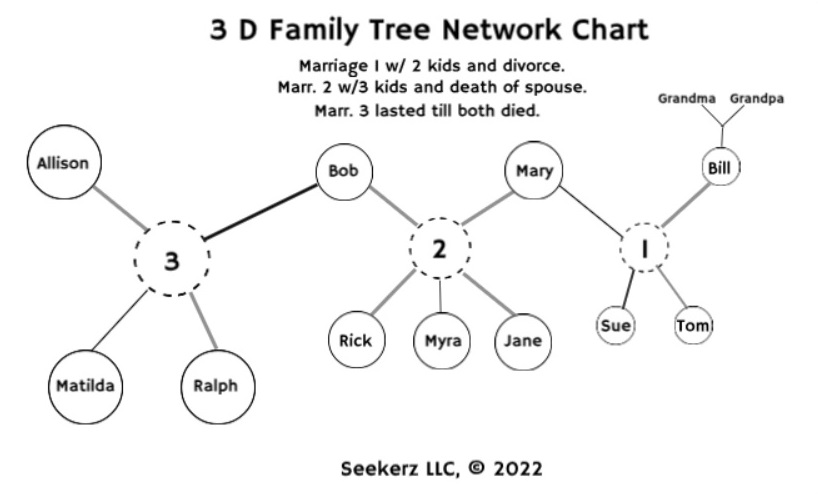Wait… Say What? Family Trees can be seen in 3D?
Yes, of course. There are software developers that are now starting to display Family Tree information in three dimensions and in a network format.
But why would we need network formatting? Aren’t the old Pedigree Charts, Family Group Sheets and Descendant charts good enough? We’ve been using them for years and years.
Well no, they aren’t really good enough. If you’ve read the prior articles on Understanding Pedigree Charts, Fan Charts, and Descendant Charts, you’ll see a reoccurring theme, they have one very big gotcha. And the gotcha is that you can’t display 3 dimensional data using 2 dimensional linear representations very easily. To do so requires that you create duplicates of the 2 dimensional representations of the data in order to display all of the data properly. And that is messy.
But, what family relationships are not linear and two dimensional? The Family Tree starts becoming 3 dimensional at the point there individuals get married more than once in their lifetime. To represent multiple marriages or partnerships, whether due to a death and remarriage, non-marriage or other means, it is far simpler to represent the family tree in a 3 dimensional network manner. There are now companies that create two dimensional representations of 3 dimensional Family data by displaying a network view of the tree in virtual reality.
The Following is a simplified example of a network segment of a Family Tree. It shows network relationships when multiple marriages are involved. A real Family Tree would show all ancestors and descendants.

By rotating and zooming in and out on the family objects, such as individuals and marriages, the three dimensional effect can clearly be seen. This gives an immersive view of the data and can display all of the marriages and children of those marriages at the same time, or at least they should be able to.
There is even a company that further extends your view of the Family Tree by allowing you to view your family tree displayed against a background of the room you are standing in, and then allows you to walk around the family tree at the same time you are walking around the room, MobileFamilTree 10. (This is not a paid advertisement, it is a company found on the Innovators Portal at RootsTech 2022.)
Three dimensional views of Family Tree data are far less confusing than the traditional two dimensional representations and now that companies are starting to create them, I suspect that they will soon be implemented by all vendors in the future.
Gotchas:
- Although the problem of representing 3 dimensional data in 2 dimensions has been solved with 3D network diagrams, we still run into the issue of what to do when you want to print out that 3 dimensional data. We run into the same problem of needing to link sheets of data to each other whenever the family gets too large to be displayed on only one page.
This issue may be of less concern these days as we are becoming less and less reliant on paper and more and more reliant on virtual reality.
—
Seekerz LLC, © 2022
